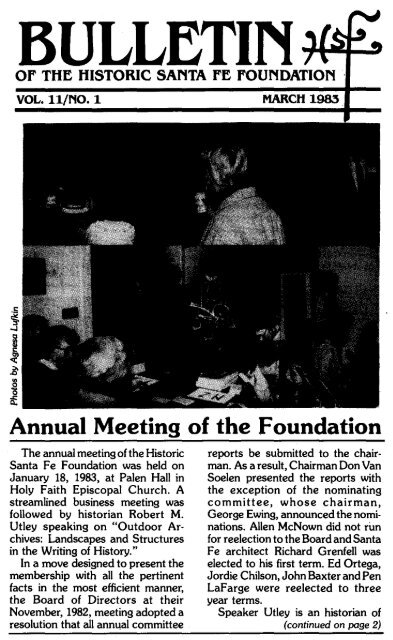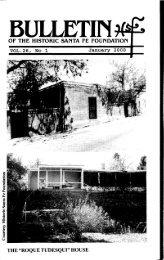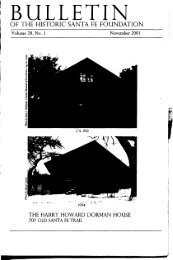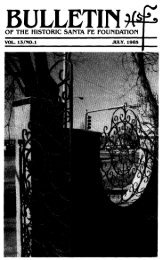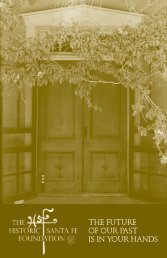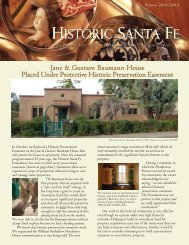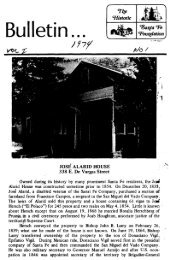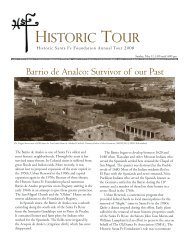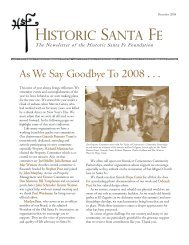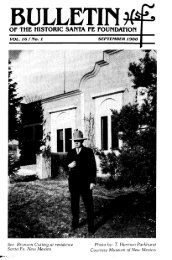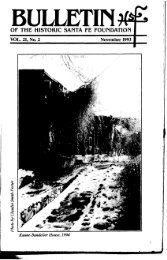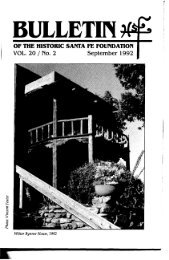BULLETIN - Historic Santa Fe Foundation
BULLETIN - Historic Santa Fe Foundation
BULLETIN - Historic Santa Fe Foundation
You also want an ePaper? Increase the reach of your titles
YUMPU automatically turns print PDFs into web optimized ePapers that Google loves.
<strong>BULLETIN</strong><br />
OF TilE IIISTORIC SANTA FE FOUNDATION<br />
VOL. II/NO. 1 MARCil 1983<br />
Annual Meeting of the <strong>Foundation</strong><br />
The annual meeting of the <strong>Historic</strong><br />
<strong>Santa</strong> <strong>Fe</strong> <strong>Foundation</strong> was held on<br />
January 18, 1983, at Palen Hall in<br />
Holy Faith Episcopal Church. A<br />
streamlined business meeting was<br />
followed by historian Robert M.<br />
Utley speaking on "Outdoor Archives:<br />
Landscapes and Structures<br />
in the Writing of History."<br />
In a move designed to present the<br />
membership with all the pertinent<br />
facts in the most efficient manner,<br />
the Board of Directors at their<br />
November, 1982, meeting adopted a<br />
resolution that all anm~al committee<br />
reports be submitted to the chairman.<br />
As a result, Chairman Don Van<br />
Soelen presented the reports with<br />
the exception of the nominating<br />
committee, whose chairman,<br />
George Ewing, announced the nominations.<br />
Allen McNown did not run<br />
for reelection to the Board and <strong>Santa</strong><br />
<strong>Fe</strong> architect Richard Grenfell was<br />
elected to his first term. Ed Ortega,<br />
Jordie Chilson, John Baxter and Pen<br />
LaF arge were reelected to three<br />
year terms.<br />
Speaker<br />
Utley is an historian of<br />
(continued on page 2)
Annual Meeting (continued from page 1)<br />
impressive credentials. He started<br />
his career while still in college, working<br />
in 1947 at the Custer Battlefield<br />
National Monument. From that time<br />
he went on to be historian in a number<br />
of important positions, including<br />
historian for the Joint Chiefs of Staff.<br />
For several years he worked for the<br />
National Park Service, and became<br />
Chief Historian for that service.<br />
From 1977 until his retirement in<br />
1980 he was Deputy Executive Director<br />
of the President's Advisory<br />
Council on <strong>Historic</strong> Preservation.<br />
In his presentation to the <strong>Foundation</strong>,<br />
Utley discussed the advantages<br />
to historians of actual field work, citing<br />
those American scholars who<br />
really stood at the Cumberland Gap<br />
and at South Pass before embarking<br />
on their literary efforts. Leavening<br />
his talk by recounting incidents such<br />
as the scattering of his manuscript<br />
over the Butterfield Stage route and<br />
digging a pick-up out of the mud on a<br />
mountain pass in Utah, Utley gave<br />
an entertaining and instructive program<br />
both for historians and readers<br />
of history.<br />
<strong>Foundation</strong> member Anita<br />
Thomas brought up the question of<br />
the reconstruction planned by the<br />
city for the Washington Avenue<br />
Paseo de Peralta intersection, objecting<br />
to the widening. This position<br />
was seconded by Mary Jean Cook<br />
and Pen LaFarge.<br />
After adjournment, members enjoyed<br />
the traditional refreshment of<br />
hot chocolate and biscochitos.<br />
1983 Chairman Elected<br />
Louann Jordan, the <strong>Foundation</strong>'s<br />
new Chairman, has been Vice-Chairman<br />
for two years and is serving the<br />
last year of her second term on the<br />
Board. A resident of <strong>Santa</strong> <strong>Fe</strong> for<br />
more than 12 years, Ms. Jordan is a<br />
free-lance graphic designer. She<br />
teaches graphic arts and the popular<br />
"Sketch Tour of <strong>Historic</strong> <strong>Santa</strong> <strong>Fe</strong>"<br />
at the College of <strong>Santa</strong> <strong>Fe</strong> Continuing<br />
Education.<br />
"I look forward to an active year in<br />
the <strong>Foundation</strong>," she said. "We will<br />
be more visible in these times of<br />
great changes in <strong>Santa</strong> <strong>Fe</strong>." She<br />
pledges to support a closer cooperation<br />
with local historic groups, to<br />
sponsor educational programs, to<br />
expand the research program and to<br />
offer more membership activities.<br />
Louann Jordan
1982 CHAIRMAN'S REPORT<br />
As reported at the Annual Meeting,<br />
I have completed two years as<br />
your chairman of the <strong>Foundation</strong><br />
and this year completes my six-year<br />
term. We believe it is in the best interest<br />
of the organization that a member<br />
is compelled to go off the board<br />
for at least one year.<br />
A lot has transpired since 1978.<br />
Renovation of the Tully House was<br />
being done under the able direction<br />
of Donna Quasthoff and the dedication<br />
of many others. Later the<br />
<strong>Foundation</strong> was given the Delgado<br />
House and EIZaguan. As a result the<br />
<strong>Foundation</strong>'s total assets now<br />
exceed half a million dollars. It has a<br />
good liquid position so that it would<br />
be able to move quickly ifa need presented<br />
itself.<br />
This past year the Board spent<br />
good deal of time developing<br />
stronger committee structure wit<br />
budget responsibilities so the ft.:<br />
Board was not spending so mue<br />
time in its monthly meetings OVI<br />
minutiae of detail. Other accomplisl<br />
ments were negotiation of a ne<br />
lease for the Tully House, major ir<br />
provements at El Zaguan and fin.<br />
ization of the LaCorte Building la1<br />
suit. The third issue of Old <strong>Santa</strong> J<br />
Today was published and the Hi<br />
monium rededicated in Loret<br />
Chapel by Archbishop Robert<br />
Sanchez.<br />
The Board looks forward to a ch<br />
lenging 1983. -Don VanSoe<br />
Annual Meeting of the <strong>Foundation</strong>
REGISTERS AND PLAQUES<br />
One of the most common words in<br />
the historic preservation vocabulary<br />
is the "Register," and perhaps the<br />
question most frequently asked concerning<br />
the status of an endangered<br />
historic structure is, "Is it on the National<br />
or State Register." Since this is<br />
the case, perhaps a word of explanation<br />
as· to its meaning and importance<br />
is in order. A Register is the<br />
formal listing of historic structures,<br />
sites, districts and objects in a formal<br />
document of registration, under the<br />
control of a designated authority<br />
who is responsible for its maintenance.<br />
Hence, the first, and most important,<br />
action to be taken for the<br />
preservation of an historic property<br />
is its placement on the National and/<br />
or State Register and, in <strong>Santa</strong> <strong>Fe</strong>,<br />
designated as "worthy of preservation"<br />
by the<br />
<strong>Foundation</strong>.<br />
<strong>Historic</strong> <strong>Santa</strong> <strong>Fe</strong><br />
In order to qualify for registry,<br />
properties must be accurately documented<br />
as to their historical integrity<br />
and importance. The documentation<br />
should be critically reviewed by a<br />
qualified board or committee empowered<br />
to approve or deny the inclusion<br />
of the property on the<br />
register.<br />
The federal government through<br />
the National Park Service of the Department<br />
of the Interior is responsible<br />
for two registers, the older and<br />
more restrictive Registered National<br />
Landmarks and the much more extensive<br />
and better known National<br />
Register of <strong>Historic</strong> Places. The <strong>Historic</strong><br />
Sites Act of 1935 declared the<br />
preservation of historic sites, buildings<br />
and objects of national significance<br />
for public use to be a matter of<br />
national policy. The <strong>Historic</strong> Sites<br />
Survey was created to locate and<br />
identify such sites. Renamed in 1957<br />
as the National Survey of <strong>Historic</strong><br />
Sites and Buildings, the Registered<br />
National Landmarks was then established<br />
to recognize sites of special<br />
national importance as a means of<br />
encouraging their owners to protect<br />
them. <strong>Santa</strong> <strong>Fe</strong> has three National<br />
Landmarks: the Plaza, the Palace of<br />
the Governors and the Barrio de<br />
Analco.<br />
Among the provisions of the comprehensive<br />
1966 National <strong>Historic</strong><br />
Preservation Act was the mandating<br />
of the Secretary of the Interior to<br />
maintain the National Register of<br />
<strong>Historic</strong> Places, a much expanded<br />
register to be composed of districts,<br />
sites, structures and objects of significance<br />
in American history, archeology,<br />
architecture and culture. In<br />
order to be eligible for federal historic<br />
preservation funds and grantsin-aid<br />
a state had to enact its own historic<br />
preservation legislation bringing<br />
it into compliance with the exacting<br />
requirements of the federal act.<br />
The New Mexico legislature, under<br />
the leadership of then-Senator Tibo<br />
J. Chavez, responded by passing<br />
one of the model state laws, the 1969<br />
Cultural Properties Act. An important<br />
provision was the establishment<br />
of the New Mexico State Register of<br />
Cultural Properties, to be maintained<br />
by the Cultural Properties Review<br />
Committee, composed of seven<br />
professional historians, archeologists<br />
and architects. The Committee<br />
was also designated as the agency<br />
for recommending sites and properties<br />
to be placed on the National<br />
Register. According to the State <strong>Historic</strong><br />
Preservation Bureau, <strong>Santa</strong> <strong>Fe</strong><br />
at present is represented by 21 sites<br />
on the National Register, including<br />
the <strong>Santa</strong> <strong>Fe</strong> <strong>Historic</strong> District itself, .<br />
all of which are automatically on the<br />
State Register. An additional 70<br />
properties are on the State Register
for a total of 91.<br />
Thanks to the <strong>Historic</strong> <strong>Santa</strong> <strong>Fe</strong><br />
<strong>Foundation</strong>, however, the program<br />
for the registry and preservation of<br />
significant structures and sites in our<br />
ancient capital had already been in<br />
existence for fiveyears when the <strong>Historic</strong><br />
Preservation Act was passed.<br />
One of the priorities of the <strong>Foundation</strong><br />
after it was organized in 1961<br />
was a continuing research program<br />
to identify and document historic<br />
structures. Those deemed worthy of<br />
preservation on the basis of their recorded<br />
history were then eligible to<br />
display the <strong>Foundation</strong> plaque.<br />
Shortly thereafter, a city ordinance<br />
established the <strong>Historic</strong> Sites Commission<br />
to determine those buildings<br />
which should receive officialcity protection.<br />
This commission, which was<br />
in existence until the recent revision<br />
of the city historical district ordinance,<br />
recommended that the list of<br />
structures documented and accepted<br />
by the <strong>Foundation</strong> form the city<br />
register. The first edition of Old<br />
<strong>Santa</strong> <strong>Fe</strong> Today, containing the story<br />
of 33 significant sites and buildings,<br />
was published in 1966, about the<br />
same time as Congress was enacting<br />
the National <strong>Historic</strong> Preservation<br />
Act. More than half of the properties<br />
now on the State and National Registers<br />
were entered on the basis of the<br />
documentation prepared by the<br />
<strong>Foundation</strong>'s.research committee.<br />
Plaques<br />
A plaque designating a structure<br />
as of historical importance is an effective<br />
visual method of dignifying its<br />
status and making the public aware<br />
of the need for protection. Markers<br />
denoting recognition on one or more<br />
registers are affixed to many <strong>Santa</strong><br />
<strong>Fe</strong> buildings and structures. The<br />
<strong>Foundation</strong>'s distinctive bronze<br />
medieval-shield-shaped emblem,<br />
containing the historical name of the<br />
building and the phrase, "The <strong>Historic</strong><br />
<strong>Santa</strong> <strong>Fe</strong> <strong>Foundation</strong> finds this<br />
building worthy of preservation" is<br />
the most familiar. The National Park<br />
Service has no program for providing<br />
plaques for National Register<br />
sites, although approved bronze<br />
markers, rectangular in shape, designating<br />
such registry can be purchased<br />
by the owner from commercial<br />
sources.<br />
Official bronze plaques designating<br />
National landmark status are,<br />
however, provided by the Department<br />
of the Interior. In addition to the<br />
name of the site and the date of registry<br />
these markers carry the text,<br />
"This site possesses exceptional<br />
value in commemorating and illustrating<br />
the history of the United<br />
States. U.S. Department of the Interior,<br />
National Park Service." That<br />
for the Plaza was installed in 1962<br />
outside the iron fence on the south<br />
side of the Soldiers' Monument. Although<br />
eligible for all accepted<br />
plaques, the venerable Palace of the<br />
Governors displays only its National<br />
<strong>Historic</strong> landmark designation in<br />
1961, mounted on the inside wall of<br />
the reception area, facing the main<br />
entrance.<br />
The Palace does, however, have<br />
other markers. Many years ago,<br />
handsome wooden framed texts<br />
were installed on the exterior of the<br />
south wall on both sides of the main<br />
entrance which give a brief history of<br />
the evolution of the Museum of New<br />
Mexico, as well as of the building itself.<br />
The text to the right reads:<br />
"The Palace of the Governors<br />
Seat of the Museum of New Mexico<br />
School of American Research<br />
and <strong>Historic</strong>al Society of N.M.<br />
Dedicated to the recovery,<br />
Conservation and display of<br />
the Archaeology, Ethnology<br />
History and Art of the Southwest<br />
The Palace is a State Monument."<br />
(continued on page 6)
Registers and Plaques (continued from page 5)<br />
That on the left states:<br />
"El Palacio Real<br />
Fortress and castle built by the<br />
Order ofthe SpanishCrown 1610-1612<br />
Seat of governmentunder three flags<br />
Spanish, Mexican& American<br />
From 1610 to 1910 the residence<br />
of over a hundred governors &<br />
Captains General<br />
The oldest public building in the<br />
United States<br />
An identical plaque with this wording<br />
is mounted on the Lincoln Avenue<br />
side of the Palace to the right of the<br />
blue gate.<br />
The design for an official plaque<br />
for State Registered sites was adopted<br />
by the Cultural Properties Review<br />
Committee in 1974. Fashioned of<br />
permaloy and slightly rounded in<br />
shape, this designation carries the<br />
Zia symbol logo of the Committee.<br />
The name of the site, a number listing<br />
its rank on the Register and a<br />
brief statement of significance are inscribed<br />
in the center of the symbol,<br />
surrounded by the phrase "Registered<br />
Cultural Property State of New<br />
Mexico." State Register plaques may<br />
be purchased by owners of registered<br />
properties through the good<br />
offices of the <strong>Historic</strong>al Society of<br />
New Mexico.<br />
No National <strong>Historic</strong> Landmark<br />
Winter in Taos<br />
plaque commemorates the Barrio de<br />
Analco. Because of its special significance,<br />
however, a <strong>Foundation</strong><br />
marker with a lengthier text is installed<br />
on the northeast corner of the<br />
Antique Art Shop at the exit for de<br />
Vargas Street. "This neighborhood<br />
was first established in the early<br />
1600s by TIascalan Indian servants<br />
for whom the original San Miguel<br />
chapel was built. Razed during the<br />
Pueblo Revolt in 1680; resettled by<br />
families of Spanish soldiers after the<br />
de Vargas reconquest of 1693 when<br />
the chapel was reconstructed."<br />
The "Professor J.A. Woods<br />
House" on Armijo Street, one of the<br />
most recent structures to be documented<br />
by the <strong>Foundation</strong> and to be<br />
placed on the State Register (Bulletin,<br />
October, 1981) is probably the<br />
most plaqued building in the city, displaying<br />
the <strong>Foundation</strong> and State<br />
Register symbols and the bronze<br />
plaque authorized by the U.S. Department<br />
of the Interior. The text<br />
states that the house "Has been<br />
designated as a significant property<br />
within the <strong>Santa</strong> <strong>Fe</strong> <strong>Historic</strong> District"<br />
This is apparently the only National<br />
Register plaque presently installed<br />
on a <strong>Santa</strong> <strong>Fe</strong> historic<br />
structure. -Myra EllenJenkins<br />
Las Palomas de Taos recently announced<br />
the reprinting of Winter in<br />
Taos by Mabel Dodge Lujan. The<br />
original edition is now considered a<br />
r~re book. The new 264-page paperback<br />
edition has a foreword by<br />
Frank Waters and 20 photographs,<br />
some by Ernest Knee. It retails for<br />
$14.95. If you are unable to find it<br />
locally, call Las Palomas de Taos,<br />
758-9456.
Instant Old Town in Texas<br />
Old-time fervor<br />
Addison, Tex., doesn't seem to<br />
think much of its existing old buildngs.<br />
So it's tearing down about a<br />
ozen 30-to-40-year-old structures<br />
o build a 35-acre "Old Town" rereating<br />
a late 19th-century downown.<br />
Private developers will construct<br />
he $13 million project and willhave<br />
trict design control over the archiecture.<br />
Three styles willbe allowed:<br />
lacy French style recalling New<br />
rleans; emulations of San Francjsco's<br />
Eastlake row houses; and<br />
Queen Anne brick indigenous to<br />
small Texas towns. No building will<br />
exceed three stories, and flashing or<br />
garish signs will be banned.<br />
City officials deny that they are<br />
trying to create "instant history" in<br />
the Dallas suburb, but are more interested<br />
in "architectural design."<br />
Said town manager Ron Whitehead,<br />
"You can get caught up in the excitement<br />
of this kind of thing because it's<br />
so neat."<br />
-Preservation News,<br />
November 1982<br />
"Somewhere in there /s an old house screami"J<br />
iD qetout~\
Our First Crossword Puzzle<br />
by Agnesa<br />
Lufkin<br />
Across<br />
1. Horizontal wood members between vigas and<br />
dirt roof.<br />
9. Dark-hued, somber.<br />
12. Conclusion or judgment.<br />
13. Wall-strengthening structure.<br />
17. Fireplace.<br />
18. Building designer.<br />
19. Constructed.<br />
20. Day.<br />
21. Small drink.<br />
23. Possessive pronoun.<br />
24. Ornamental projection (architecture).<br />
26. Dispatched.<br />
27. Northern New Mexico City.<br />
28. <strong>Foundation</strong>s.<br />
30. Hog heaven.<br />
31. Hebrew high priest and namesakes (abbr.).<br />
33. The Hill.<br />
35. Translucent sheet.<br />
36. Sicilian volcano.<br />
38. Pocket change in France.<br />
40. Cherry red.<br />
42. White (Spanish).<br />
43. Mortise and<br />
44. Exist.<br />
45. New sectarians.<br />
46. Theatre box.<br />
47. Heating fuel.<br />
48. Supporting member (arch.).<br />
49. Organic substance, insoluble in water.<br />
SO. Bulk.<br />
51. Ungentle.<br />
52. Ajar.<br />
53. Rope.<br />
Down<br />
1. Finished underside (arch.).<br />
2. Porch (with article).<br />
3. Supporting roof members.<br />
4. Prepared for anything (Latin abbr.).<br />
5. Baseball team.<br />
6. " , lookie there, ain't she pretty!"<br />
7. Chemistry abbr. for tin.<br />
8. Conduits.<br />
9. Prefix ~fore "fling" and "pend."<br />
10. Craft.<br />
11. Legal documents.<br />
13. Alloy of copper.<br />
14. Article.<br />
15. Mask.<br />
16. A group of lines of verse.<br />
18. Building mud.<br />
22. Sangre de Crlstos (abbr:).<br />
24. Built-in furniture.<br />
25. Applied color.<br />
28. First Europeans in New Mexico.<br />
29. Pointed window.<br />
30. Street named for Sigurd's foster father.<br />
31. Gypsum whitewash.<br />
34. Below a wall (with article).<br />
36. Between triglyphs in a Doric frieze.<br />
37. Cardinal number.<br />
39. Wives of rajas.<br />
41. Hard plaster.<br />
42. Mr. movies hoofer (abbr.).<br />
44. Low tone.<br />
46. Edge.<br />
47. Helium.<br />
49. Hi's buddy.<br />
SO. Pa's buddy.<br />
1982 Christmas Lighting<br />
Contest Winners<br />
East Side<br />
First Prize:<br />
Second Prize:<br />
Third Prize:<br />
Honorable Mention:<br />
Qroup:<br />
West Side<br />
First Prize:<br />
Group:<br />
Commercial'<br />
David Batts<br />
#2 Plaza Fatima<br />
Robert & Sybil Saam<br />
512 Camino del Monte Sol<br />
William Gilbert<br />
1021 Bishop's Lodge Road<br />
Robert Lovato<br />
822~ East Zia Road<br />
The Josephs and Rodriguezes<br />
1340 & 1342 Canyon Road<br />
Steve Trujillo<br />
2375 Camino Pintores<br />
Park Plazas Homeowners' Association<br />
Berardinelli Mortuary, 1399 Luisa
PUZZLE<br />
1983 Board of Directors<br />
EXECUTIVE COMMITTEE<br />
Chairman Louann C. Jordan<br />
Vice<br />
Chairman Myra Ellen Jenkins<br />
Treasurer Constant Chapman<br />
Secretary Jordie Chilson<br />
MEMBERS AT LARGE<br />
Ken Bateman<br />
John Baxter<br />
Saul Cohen<br />
George Ewing<br />
Richard Grenfell<br />
Pe~ LaFarge<br />
Agnesa Lufkiri<br />
Barbara Martin<br />
AB. Martinez, Jr.<br />
Ed Ortega<br />
EXECUTIVE SECRETARY/<br />
PROPERTY MANAGER<br />
Claudia Smith-Porter<br />
Hap! The <strong>Foundation</strong> is searching<br />
for a volunteer-writer to write<br />
articles for the Bulletin and other<br />
projects. Volunteers are also needed<br />
for Loretto Chapel and historic<br />
research.<br />
Mary Jean Cook has been commissioned<br />
by the Inn at Loretto to<br />
write the history of Our Lady of Light<br />
Chapel which will be published this<br />
fall. She is looking for a photo of the<br />
Chapel in the process of construction,<br />
as well as any heretofore unknown<br />
facts. If you can help her,<br />
please call·982-9524.
Are You A History Buff?<br />
Are you really a history buff or just<br />
toying with the idea? The following<br />
quiz will give you a clue to your<br />
status.<br />
1. Finding yourself in the proximity<br />
of a famous battlefield, you<br />
a. go on the all-day tour with a<br />
box lunch from Colonel<br />
Sanders.<br />
b. take some friends with you<br />
whom you coerce into playing<br />
the opposing forces while you<br />
direct the battle.<br />
c. drive out and get your picture<br />
taken standing next to the sign.<br />
d. decide to let bygones be<br />
bygones.<br />
2. That old house on your street is,<br />
-in your opinion,<br />
a. an eyesore.<br />
b. a good rental property.<br />
c. an unusual example of the rare<br />
architectural style, "Hidebound<br />
Vernacular."<br />
3. If a factual but tedious history<br />
book is at hand, you<br />
a. read it cover to cover without<br />
putting it down.<br />
b. read it in spurts, frequently putting<br />
it down.<br />
c. don't pick it up.<br />
4. When someone says he has been<br />
"in the archives," he means he<br />
a. went deep-sea fishing.<br />
b. has been suffering from extreme<br />
depression.<br />
c. has eyestrain from microfilm<br />
and hay-fever from dusty<br />
documents.<br />
5. "Queen Anne," "Mansard" and<br />
"Romanesque" are<br />
a. This year's new rock groups.<br />
b. next fall's new dress styles.<br />
c. Julia Child's new ways to serve<br />
nnt::\tn"s_<br />
6. When you arrive in a new city, H<br />
first thing you do is<br />
a. check to see if your "wantec<br />
poster is already up at the po<br />
office.<br />
b. look for a branch of Bergd<<br />
Goodman.<br />
c. find out if any outlaws and!<br />
captains of industry b<br />
queathed a nineteenth-centt<br />
mansion for a museum.<br />
7. A careful researcher gets his ffiI<br />
reliable facts from<br />
a. his great-aunt on his mot hE<br />
side.<br />
b. contemporary news pap'<br />
controlled by political factic<br />
c. a visiting Harvard professo<br />
d. intuition.<br />
e. none of the above.<br />
8. Basic research requires<br />
a. long late-night discussions <<br />
a bottle of jug red.<br />
b. trips to Washington (the Sn<br />
sonia"j and New York<br />
Metropolitan)<br />
c. comfortable shoes and a<br />
sandwich.<br />
d. all of the above.<br />
9. The most important functior<br />
library is<br />
a. to provide the new nove<br />
you don't have to pay fi<br />
dollars for a piece of tras<br />
b. to provide a warm plac<br />
indigents to rest betl<br />
muggings.<br />
c. to prevent anyone che<br />
out any books by keeping<br />
under glass.<br />
d. to perpetuate an obscure<br />
called "the Dewey De<br />
System."
ANSWERS<br />
Membership Renewal Time<br />
Is Here<br />
Just a reminder to all of our members that dues for 1983 are now current.<br />
Those of you who have already sent them in, we thank you. Should any member<br />
not have received their renewal card you may call our office at 983-2567<br />
between 9:00 a.m. and 1:00 p.m. and another willbe sent to you. Or you may<br />
use the one on this page to mail into the office. Perhaps you have a friend<br />
whom you think would like to be a member-just pass along the application<br />
form. We welcome one and all.<br />
NAME<br />
ADDRESS ZIP _<br />
THE HISTORIC SANTA FE FOUNDATION<br />
P.O. BOX 2535 <strong>Santa</strong> <strong>Fe</strong>, New Mexico 87501<br />
ANNUAL MEMBERSHIP DUES, 19 _~_<br />
Individual $ 6.00 _ SPECIAL CONTRIBUTION: To<br />
Husband and Wife. 10.00 _ help preserve the historic buildings<br />
Commercial 15.00 _ and sites of <strong>Santa</strong> <strong>Fe</strong> . $ _<br />
Sustaining 50.00 _ TOTAL (Income Tax<br />
Life 1,000.00 _ (Deductible) $ _<br />
o I would like to volunteer<br />
_


